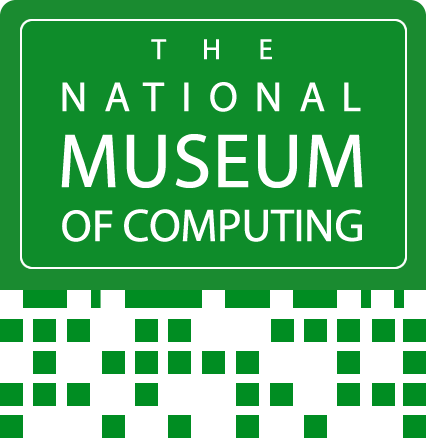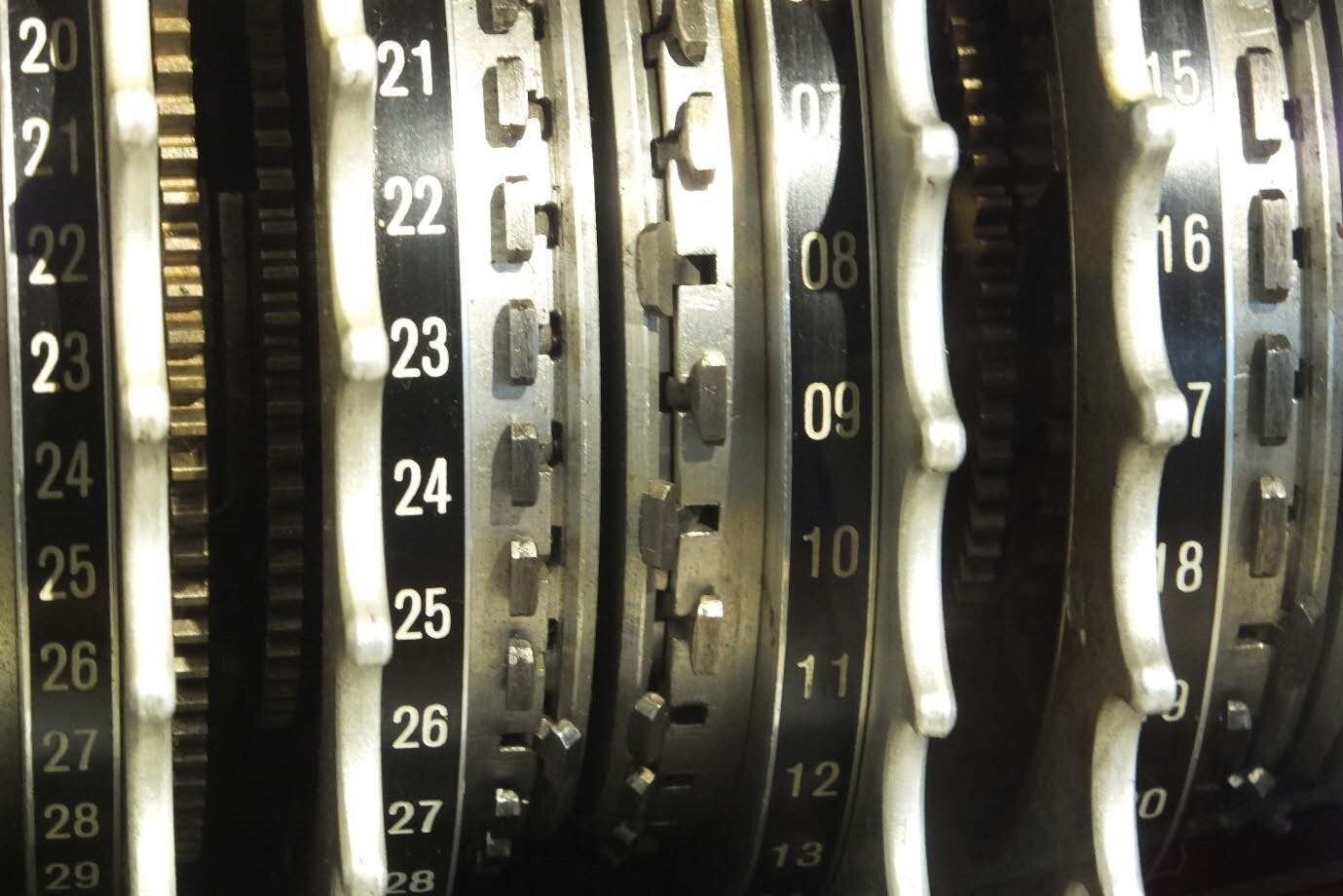Tunny
The original Tunny machine, a re-engineering of the then unseen Lorenz SZ42 cipher machine, was designed by the Post Office Research Station in 1942. It produced the final decrypts of enciphered teleprinter communications of the German High Command during World War II.
Tunny’s design was based upon the ingenious work of a team led by Bill Tutte who worked in the Research Section at Bletchley Park. No-one at Bletchley Park saw the Lorenz until one was captured after the war, so Tutte had to work out the logical structure of the highly sophisticated 12-rotor machine using samples of its encrypted output and the manual decrypts laboriously and ingeniously produced by Colonel John Tiltman.
The 12 rotors of the Lorenz machine gave it 1.6 million billion possible start positions, so the decryption of messages by the Testery was an astonishing achievement.
By the end of the war, the Tunny machines are thought to have numbered between 12 and 15, operated continuously and were probably located in Block F at Bletchley Park, a short distance from Block H where the Colossus computers were housed. The Tunny machines were dismantled and recycled after the war.
After hundreds of man-hours work, a team of TNMOC volunteers led by John Pether and John Whetter has reconstructed a fully operational Tunny machine based on fragmentary evidence consisting of a few photographs, partial circuit diagrams and the fading memories of a few original Tunny operators.
Heath Robinson
This was the machine that inspired Colossus.
The Heath Robinson was an early attempt to automate codebreaking. It was specifically designed to tackle the hugely complex Lorenz cipher, used by Hitler and his generals to communicate strategic messages.
The complexity of the codebreaking machine resulted in its being named in honour of W Heath Robinson, the illustrator, but he would never have known of this tribute because he died long before the secrecy surrounding Bletchley Park codebreaking ended.
Commissioned by the Newmanry which under Max Newman was attempting to automate codebreaking, most of Heath Robinson was built at the Telecommunications Research Establishment at Malvern. It became operational at Bletchley in June 1943 and was successful, but its limitations soon became apparent. It proved extremely difficult to keep its two tapes running in synchronisation, it required too many tape changes to tackle all but five of the Lorenz wheel patterns, it was not scalable and it required very high maintenance.
Tommy Flowers of the GPO laboratories in Dollis Hill, London, was asked if he could improve upon the Heath Robinson, but rather than modify it, Flowers proposed the development of Colossus to overcome the Heath Robinson limitations. Flowers’ use of valves in place of the synchronising tape on the Robinson was a vital breakthrough.
Even after the deployment of Colossus in February 1944, the Heath Robinson continued to be developed and used in tackling the Lorenz cipher. By the end of the war, two ‘Super Robinsons’ were operational and another two under development.
After the war, one Super Robinson went to Eastcote, Middlesex and was probably operational until 1950s. Further development after the war led to Colorob, a combination of Robinson and Colossus, which became operational in 1955.
Lorenz SZ42
German High Command communicated across some 30 high frequency radio links in German-occupied territories in Europe using Lorenz encryption machines. It is estimated that about 200 Lorenz machines were in existence during World War II, but only four are known to have survived. The Lorenz SZ42 machine displayed at TNMOC has the serial number 1137 and was used at the German HQ in Norway at Lillehammer, north of Oslo. Since Norway was occupied by the Germans until the end of the war, we believe it will have received the final surrender instruction message at 24:00 hrs on 8 May 1945, marking the end of the war. This machine is on long term loan from The Norweigian Armed Forces Museum in Oslo.
Alongside the Lorenz is an original Spruchtafel, the Lorenz wheel-setting aid. It is one of only two thought to be in existence today.
Next to this is a rare German Military Lorenz Teleprinter which would have been used in conjunction with a Lorenz SZ42 cipher machine to transmit and receive messages between Berlin HQ and Army Group Commanders.
The Tiltman Break
With millions of possible wheel combinations, the Lorenz-encrypted communications were thought to be unbreakable.
But a human error led to the breakthrough that cracked the code. On 30 August 1941, against all the rules, a Lorenz message was re-sent between Berlin and Athens because the first was not received properly. They used the same wheel settings – and crucially the second message was shortened by the use of abbreviations. This gave Colonel John Tiltman the insight he needed to break the code by hand in ten days.
The three phases of finding the wheel settings of the Lorenz SZ42:
Jul 1942 - Jul 1943 by hand with great patience in the Testery.
Jun 1943 - Jan 1944 with the temperamental Heath Robinson.
Feb 1944 - May 1945 with the fast and reliable Colossus computers.
Opening day re-union
On 26 May 2011, the Tunny Gallery was opened in the presence of four wartime veterans: Capt Jerry Roberts, a shift leader in the Testery, Helen Currie, an ATS who operated Tunny, John Croft CBE, an early Testery codebreaker, and Gil Hayward, a Post Office engineer who helped build the first Tunny machines and later managed a Tunny maintenance team at Bletchley Park.
Find out more and listen to Helen Currie talking about how she used Tunny.
Intercept
Our display contains typical equipment used at Knockholt to intercept the German High Command radio teleprinter transmissions and includes :
RCA communication receivers and associated telegraph terminal equipment.
Pen recorders, known as Undulators, to transfer the message data onto paper tape known as ‘slip’.
Perforators used by the slip readers to put the cipher text onto standard teleprinter punched tape.
Associated teleprinter equipment used to send the encrypted messages to Bletchley Park via GPO land lines.
The Testery & Newmanry
The Testery was set up in 1942 and led by Major Ralph Tester, the Testery was composed mainly of codebreakers and linguists. From July 1942 until the end of the war, they were breaking Tunny and the staff grew from six to 118.
The Newmanry was set up in mid 1943 and led by Max Newman, the Newmanry aimed to build machines to help in the codebreaking of Tunny. This led to the development of Colossus computers.
The Testery and the Newmanry worked closely together especially in the last 18 months of the war to break the highly important Tunny messages. “The country was lucky to have these brilliant men in the right place at the right time.” Capt. Jerry Roberts at the opening of the Tunny Gallery in 2011.
Breaking Lorenz
How it was broken at Bletchley Park - a paper by Charles Coultas
The writer of this paper was curious as to how the Lorenz machine was defeated so completely during World War 2. He searched for an explanation of how the Lorenz machine was actually broken, that he could understand.
The book Breaking Teleprinter Codes at Bletchley Park contains a great deal of information about the process, but it is intended for an academic audience and contains many statistical formulae that are beyond this writer’s level of understanding.
The attached PDF is the writer’s understanding of the process, gleaned from the Internet and the above book. If you find any errors, please let us know.
Click on the PDF link below to view/download the paper.








